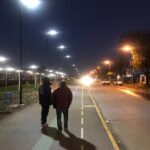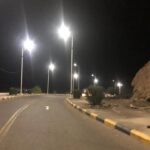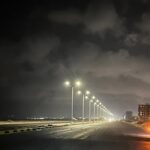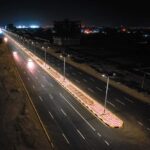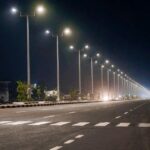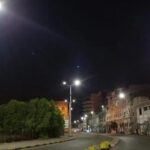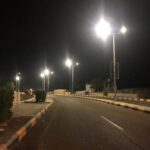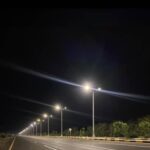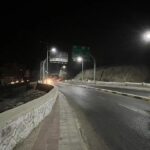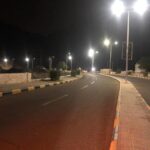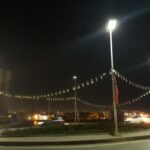In the realm of sustainable energy solutions, village solar street lights have emerged as a beacon of environmentally-conscious illumination sources. These innovative setups provide much-needed lighting in our rural areas. However, the successful implementation of a village solar street light system hinges on careful consideration of some crucial factors. These elements play a pivotal role in ensuring the effectiveness, efficiency, and longevity of such installations. Let’s dive in and discover the key aspects that must be taken into account when embarking on a village solar street light project.

Key Consideration In A Village Solar Street Light Setup
When planning for a village solar street light project, several key factors must be taken into account to ensure the success and effectiveness of the installation. What are some of these?
1. Location and Sunlight Availability
The location of the village is significant because it determines the amount of sunlight the solar panels can harness. Regions closer to the equator generally receive more direct and consistent sunlight throughout the year. In such areas, solar panels can generate more electricity, making them highly suitable for a village solar street light project. However, in locations farther from the equator or prone to extended periods of cloud cover or rainy seasons, solar panels may not receive enough sunlight to adequately power the street lights.
The orientation and placement of the solar panels within the village are also critical. Proper positioning of the panels to maximize exposure to sunlight during peak hours is vital. This includes considering potential shading from nearby buildings, trees, or other obstacles that could obstruct sunlight. Streetlights should be strategically placed to ensure they receive the most sunlight possible, especially in areas where shadows may be cast during certain times of the day.
2. Energy Efficiency
Solar street lights rely on photovoltaic panels to capture sunlight and convert it into electricity. Energy-efficient panels can convert a higher percentage of incoming sunlight into usable energy. This means more of the available solar energy can be harnessed and utilized for lighting the streets, reducing the dependence on external power sources.
Energy-efficient solar street lights can operate for longer periods, even during nights with less sunlight. This ensures that your village solar street light setup remains well-lit throughout the night, enhancing safety and security. Longer operation hours also reduce the need for backup energy sources, such as batteries or grid connections.
3. Battery Capacity and Lifespan
In a village setting, where consistent electricity supply may be unreliable, a sufficiently large battery capacity is essential to ensure the lights can operate throughout the night, even during periods of cloudy weather or low sunlight. A higher capacity battery can store more energy, providing longer operational hours and reducing the risk of your village solar street light setup running out of power prematurely.
The lifespan of the batteries is equally important. Batteries have a finite number of charge-discharge cycles before they start to degrade. In the context of your village solar street light project, using high-quality batteries with a longer lifespan is crucial to minimize maintenance and replacement costs over time. Opting for batteries with a longer lifespan reduces the frequency of replacements and ensures the lights continue to function reliably for an extended period.
4. Lighting Requirements
The lighting duration or operational hours of the solar street lights should align with the village’s activities and peak usage times. Understanding when the streets are most frequently used helps in designing a system with an appropriate battery capacity and solar panel configuration. It ensures that the lights remain functional throughout the night, enhancing convenience and safety for the community.
The choice of lighting fixtures and technologies is crucial. LED lights are a popular choice for solar street light projects due to their energy efficiency and longevity. Selecting the right fixtures with appropriate optics and beam angles ensures uniform and directed lighting, optimizing the overall performance of the system.
5. Regulatory Compliance
Adherence to regulatory requirements is essential to obtain the necessary approvals and permits for the installation of solar street lights in a village. Different regions may have varying rules and regulations related to land use, environmental impact assessments, and electrical installations. Conduct thorough research and understand these regulations to ensure that the project does not face unnecessary delays or legal challenges.
6. Mounting and Installation
The choice of mounting for your village solar street light setup is instrumental in optimizing their energy absorption. To harness solar energy efficiently, the solar panels must be strategically positioned to receive maximum sunlight exposure throughout the day. Mounting brackets or poles should be selected and installed at a height and angle that ensures unobstructed access to sunlight. A meticulous evaluation of the local terrain, tree cover, and surrounding structures is essential to identify the most suitable mounting locations.
The installation process itself should be carried out with precision and adherence to industry standards. Proper installation not only ensures the security of the solar street lights but also extends their lifespan. All electrical connections, wiring, and components must be handled by trained technicians to prevent any potential hazards. Compliance with safety regulations is paramount during installation to safeguard the village solar street light setup
7. Cost and Budget
The cost of the entire project encompasses various components, such as the purchase of solar panels, batteries, LED lights, poles, and other necessary equipment. Additionally, there are expenses related to installation, maintenance, and ongoing operational costs. Calculating these expenses accurately is crucial, as it helps determine the overall budget required for the village solar street light project.
Adequate budget provisions for contingencies, repairs, and replacements can help mitigate unforeseen issues, ensuring the uninterrupted operation of the solar street lights. Moreover, budget planning should consider the training and capacity-building of local technicians and community members to handle minor maintenance tasks, reducing long-term operational costs.
8. Backup power source
One of the primary reasons for incorporating backup power sources in a village solar street light project is reliability. Solar power generation can be affected by cloudy days, rainy seasons, or extended periods of darkness. In rural areas where consistent sunlight cannot be guaranteed throughout the year, having an alternative power source becomes imperative to maintain lighting functionality.
The use of backup power sources adds an element of resilience to the project. In situations where the primary solar power system may need maintenance or repair, the backup power source can temporarily take over, preventing any disruptions in lighting services. Be on the look-out for an advanced solar street light with battery system.
9. Monitoring and Maintenance
Monitoring is crucial as it enables project managers and stakeholders to keep a close eye on the performance of the solar street lights. Regular monitoring allows for the early detection of any technical issues, malfunctions, or deviations from expected energy production. By actively tracking the system’s performance, adjustments and interventions can be made promptly to prevent potential downtime and ensure that the lights operate optimally.
Maintenance, on the other hand, involves planned and preventive actions taken to uphold the village solar street light system’s integrity. Routine maintenance activities encompass cleaning solar panels to remove dust and debris, checking and tightening connections, and verifying the condition of batteries and other components.
Benefits of a village solar street light setup
A village solar street light setup offers numerous benefits where access to reliable electricity can be limited. What are some of these advantages?
- Cost-Efficiency: Once the initial setup costs are covered, there are minimal ongoing operational costs, as they do not rely on grid electricity.
- Environmentally Friendly: Solar street lights are eco-friendly because they produce zero greenhouse gas emissions.
- Energy Independence: Solar street lights provide a reliable source of lighting independent of the power grid.
- Reduced Electricity Bills: Villages using solar street lights can significantly reduce their electricity bills, as these lights generate their own power.
- Low Maintenance: Solar street lights typically require minimal maintenance compared to traditional grid-powered lights.
- Safety and Security: Well-lit streets contribute to increased safety for pedestrians and drivers, reducing the risk of accidents and crime.
- Extended Operating Hours: They extend the hours during which businesses can operate and community activities can take place.
- Versatility: Solar street lights can be installed in remote and off-grid locations, making them suitable for villages and communities that lack access to conventional electricity.
- Long Lifespan: Quality solar street lights are designed to be durable and have a long lifespan, often exceeding 20 years
Conclusion
When planning a village solar street light setup, it is imperative to carefully assess and address all the crucial factors to ensure the system’s efficiency and durability. Do you need a solar street light? Contact us.
Discover some crucial tips to maintain your solar street light.





